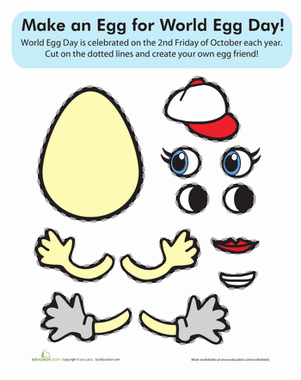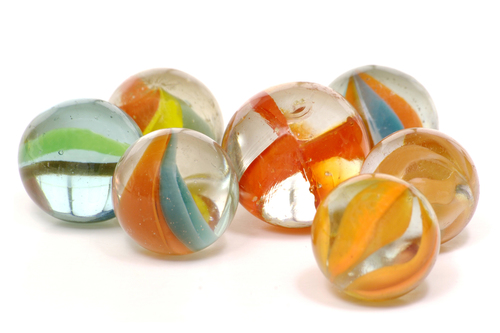Activity
Design Challenge: Glowing Bouncy Egg
Guide your child through a fun science experiment that allows them to observe the changes to an egg after it soaks in vinegar for a few days. At the end of this activity, your child should have transformed their egg into a glowing, bouncy “ball” that they can play with!
Grade
Subject
Thank you for your input.
What You Need:
- One raw egg
- White vinegar
- A highlighter or Vitamin B-50 capsules (to stain the egg with color)
- A cup (ideally a clear one)
- Optional: A blacklight to visualize the egg’s glow-in-the-dark capabilities at the end
What You Do:
- First, explain the prompt to your child. Show them the materials and tell them that their job is to use what you’re giving to transform their egg into a glowing, bouncy ball.
- Rather than immediately telling your child the step-by-step procedure, ask them if they have any ideas as to how they will complete this challenge. Some questions you can ask your child to guide them:
- What do you think the vinegar will be used for? What are some properties of vinegar? (Answer: Explain that vinegar has a property called acidity, which is what gives it a bitter taste.)
- Since vinegar is acidic, that means it is strong enough to dissolve some things. Do you think it can dissolve any part of the egg? (Answer: The vinegar will dissolve the egg’s shell.)
- What do you think the highlighter (or vitamin capsules) will do to the egg? (Answer: It will transfer its color onto the egg.)
- After you and your child have worked together to brainstorm methods to use the materials, you can start explaining the step-by-step procedure. Be sure to ask your child why they think each step of the process is necessary so that they develop a conceptual understanding of what they’re doing.
Here is the procedure for creating the glowing, bouncy egg:
- First, pour some vinegar into a cup (enough so that the egg will be fully submerged).
- Ask your child, “Why do you think vinegar will be useful? Why are we using vinegar instead of water, for example?” (Answer: Vinegar has a property called acidity, which is why it has a strong, bitter taste. When the egg soaks in vinegar, the vinegar’s acidity will make the eggshell dissolve, or get removed. This will turn the egg into a bouncy ball.)
- Next, squeeze out the liquid from inside a highlighter into the cup of vinegar. If you’re using Vitamin B-50 capsules, crush them up and pour the powder into your glass of vinegar.
- Ask your child, “Why do you think we are pouring highlighter liquid (or crushed vitamin capsules) into the cup of vinegar?” (Answer: Explain to your child the concept of color transfer by taking a blank piece of paper and drawing on it with your highlighter. Explain to your child how the color from the highlighter soaks into the white piece of paper and makes it glow. Remind your child that their goal is to make the egg glow. Explain that the highlighter liquid, or vitamin capsules, in the cup of vinegar will act like the highlighter on the piece of paper: It will transfer its color onto the egg.)
- Next, have your child place the egg into the glass of vinegar. Leave the egg in the glass of vinegar for two days.
- Ask your child to make some predictions about what they will observe when they return in two days. Depending on your child’s age and writing abilities, ask them to write down their predictions or write down your child’s predictions for them. This way, your child can refer back to their hypotheses after the experiment is over.
- After two days, have your child return to their experiment. Remove the egg from the glass and have your child peel off the outer skin (it should come off easily).
- Ask your child, “What do you think happened to the eggshell?” If they are stuck, remind your child of vinegar’s acidic properties as an explanation to why the shell dissolved.
- Finally, your child can test their experiment! If you opted to use a blacklight, go into a dark room and turn on your black light to see if the egg is glowing. Have your child attempt to bounce the egg on a smooth, hard surface that you don’t mind getting a little messy. It’s not necessary to have a blacklight in order to complete this activity, but it’s a nice bonus so that your child can see their egg glowing at the end. Without the blacklight, your child can still notice how their egg has become bouncy.
- If anything went wrong and your child’s egg is not glowing or bouncy, help them identify what led to this. Then, be sure to encourage them to try out this experiment again!
Related learning resources

Design Challenge: Gumdrop Towers
Activity
Design Challenge: Gumdrop Towers
In this fun design challenge, your child will get creative with making structures out of toothpicks and gumdrop candies.
kindergarten
Science
Activity

STEM Design Challenge Cards
Worksheet
STEM Design Challenge Cards
These STEM design challenge cards ask learners to build something new for a specific reason or purpose and are a great way to foster creative thinking.
2nd grade
Science
Worksheet

Easter Egg Patterns
Lesson plan
Easter Egg Patterns
Kindergarten students will love becoming the Easter Bunny’s assistant as they design their very own Easter egg patterns!
kindergarten
Math
Lesson plan

STEM Design Challenge: Plan, Reflect, Revise
Worksheet
STEM Design Challenge: Plan, Reflect, Revise
Children will plan our their STEM design, reflect on the process of building their creation, and brainstorm ways they could make their design even better.
preschool
Science
Worksheet

Design Challenge: Building a Bridge
Activity
Design Challenge: Building a Bridge
In this exciting and empowering challenge, your child will construct a bridge using marshmallows and toothpicks!
preschool
Science
Activity

Chair Design Challenge
Activity
Chair Design Challenge
...In this activity, your student will be presented with a unique design engineering challenge: Build a chair that is designed to meet the specific size and shape of a...
2nd grade
Science
Activity

STEM Design Challenge Cards for Young Learners
Worksheet
STEM Design Challenge Cards for Young Learners
Use these STEM design challenges to foster creativity and critical thinking skills in young learners while introducing them to the engineering process.
preschool
Science
Worksheet

STEM Design Challenge: Brainstorm and Reflection Sheet
Worksheet
STEM Design Challenge: Brainstorm and Reflection Sheet
Help children hone their creativity and critical thinking skills while providing hands-on experience with design planning, reflection, and writing process.
2nd grade
Reading & Writing
Worksheet

Design Challenge: Creating Animal Habitats
Activity
Design Challenge: Creating Animal Habitats
In this design thinking activity, your child will choose an animal to research, learn about the animal’s habitat, and then replicate the animal's habitat using household items.
2nd grade
Reading & Writing
Activity

World Egg Day
Worksheet
World Egg Day
Here's a holiday you didn't know existed: World Egg Day! Celebrate by cutting and pasting your own egg man or woman.
preschool
Arts & crafts
Worksheet

Design Challenge: Making a Catapult
Activity
Design Challenge: Making a Catapult
...Mention that there isn’t only one way to go about this challenge....
preschool
Science
Activity

Design Challenge: Marble Labyrinths
Activity
Design Challenge: Marble Labyrinths
...How could using the design process help create more complex or well thought out mazes?
Now, introduce the design challenge to your child....
1st grade
Science
Activity

